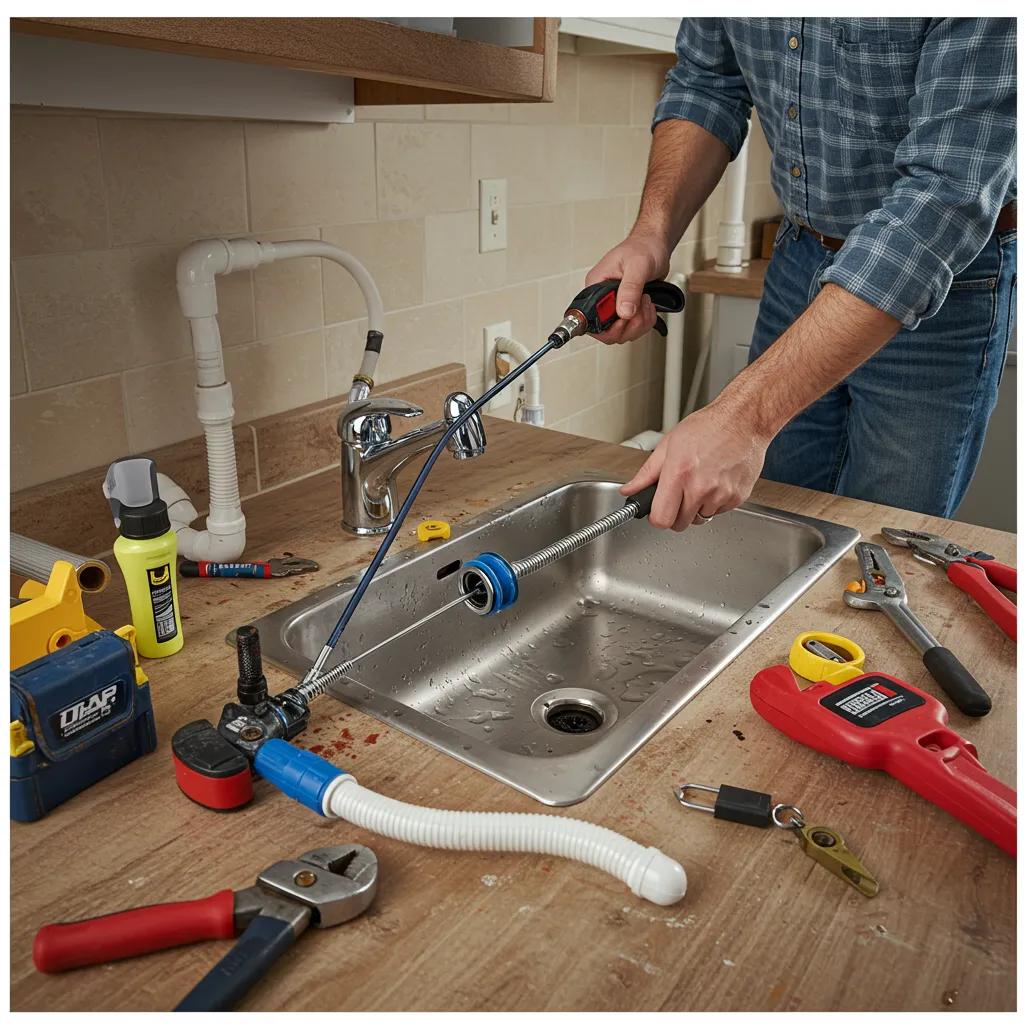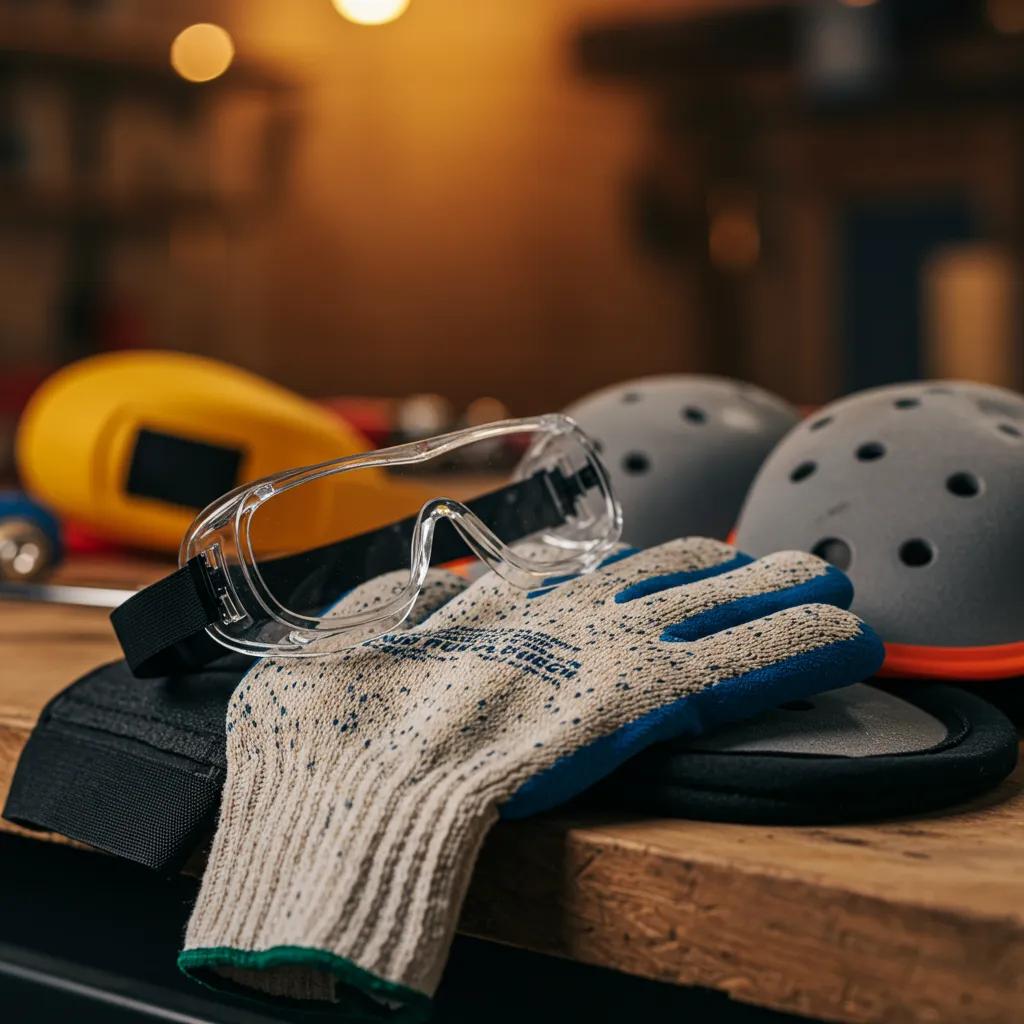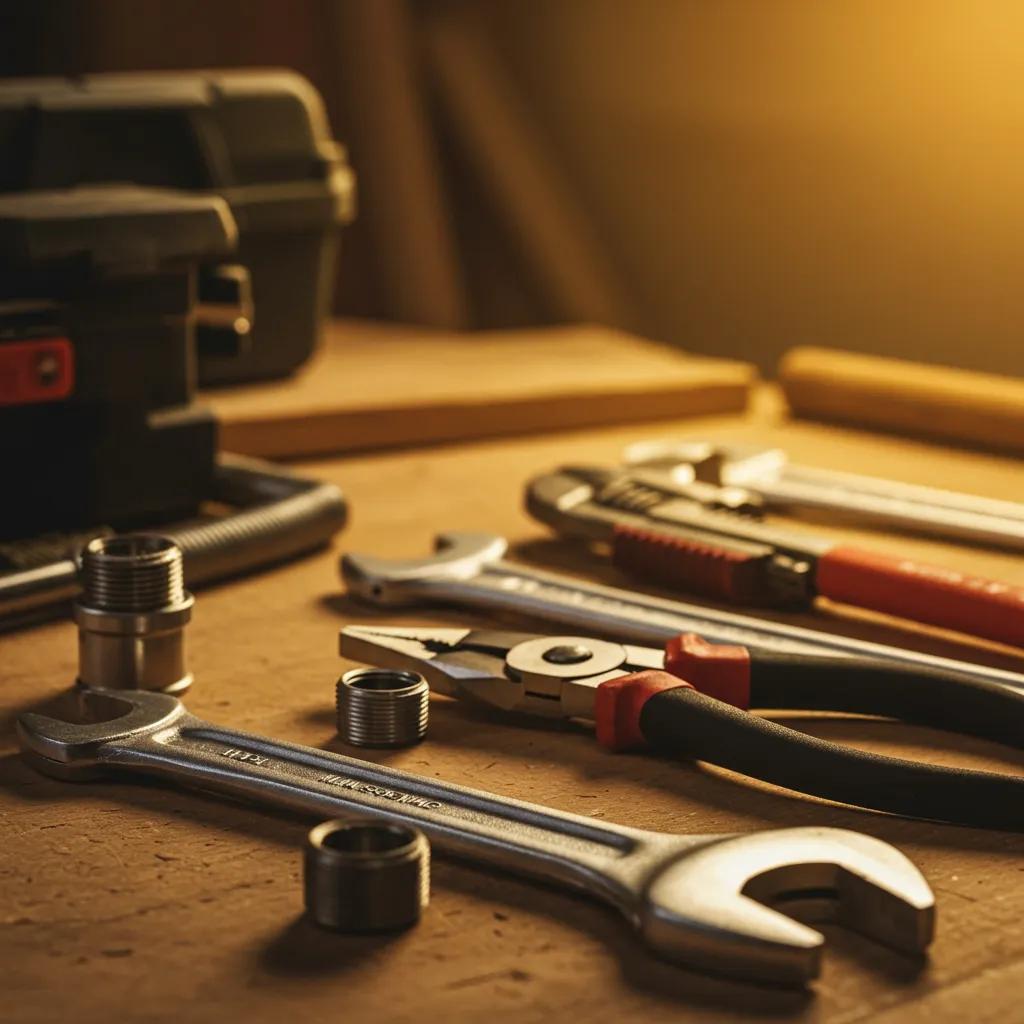Must-Have Plumbing Tools for Every Homeowner: Essential DIY Gear and When to Call a Pro
Every homeowner eventually faces leaks, drips, or clogs that need immediate attention. Having the right plumbing tools on hand can speed up repairs, minimize water damage, and give you the confidence to tackle DIY plumbing tasks. These essential tools provide the leverage and sealing power you need to tighten fittings, clear blockages, and stop minor leaks before they turn into costly emergencies. For instance, a simple adjustable wrench can fix a dripping faucet, while a good plunger can prevent a flooded toilet. This guide will cover the main categories of tools, explain how to safely use drain clearing equipment, compare wrenches and pliers for fixture repairs, outline sealing and cutting tools, highlight crucial safety gear, and let you know when it’s time to call Maxx Grip Plumbing & Sewer Service Inc. for expert help.
What Are the Essential Plumbing Tools Every Homeowner Should Have?
Keeping your home’s plumbing in good shape relies on a set of basic hand tools and emergency items that make repairs more effective and reduce your need for outside help. By stocking your toolkit with the right gear, you can handle common leaks, tighten loose connections, and manage minor clogs without delay. For example, having both a basin wrench and plumber’s tape ready means you can secure under-sink connections and seal threaded joints to stop drips.
Which Basic Plumbing Hand Tools Are Needed for Home Repairs?
A solid set of hand tools allows homeowners to safely and precisely tighten, loosen, and adjust plumbing components. Plumbing services are important for any homeowner to ensure their systems are well-maintained.
- Adjustable wrench: Use this to turn hex nuts on faucets and shut-off valves without slipping.
- Slip-joint pliers: Grip pipes of various sizes to tighten compression fittings.
- Basin wrench: Reach those tricky nuts located under sinks and behind fixtures.
Each tool is designed for specific jobs—from gripping curved surfaces to securing flat-sided fittings. Having these three gives you the versatility for most small repairs. Understanding how each tool works prepares you for routine adjustments and sets you up for tackling more complex maintenance tasks in the next section.
What Tools Help with Common Plumbing Repairs and Maintenance?

For maintenance tasks like sealing threads, cutting damaged pipes, and clearing minor blockages, you’ll need specialized implements:
- Plumber’s tape (Teflon tape): Wrap this around threaded joints to prevent leaks under normal pressure.
- Pipe cutters: Use these to score and cleanly cut copper or PVC pipe for replacement.
- Drain snake (hand auger): This tool reaches further than a plunger to break up minor clogs.
These implements help you service pipelines efficiently, reducing water leaks and wear on fixtures. Having these tools ready means you can tackle faucet leaks and minor clogs without needing to call a professional, unless deeper issues surface.
How Do Emergency Plumbing Tools Protect Your Home?
In the event of a sudden leak or burst pipe, having emergency tools readily available can prevent extensive water damage:
- Shut-off valve key: Quickly operate main water valves, even hidden ones, to stop the flow.
- Leak repair clamp: Use this to temporarily cover a small crack or pinhole until a permanent fix can be made.
- Flashlight with magnetic base: Illuminate dark under-sink areas for quick inspections.
Equipping a small emergency kit gives you immediate control during unexpected plumbing failures and naturally leads to specialized drain clearing solutions when basic tools aren’t enough.
How Do You Use Drain Clearing Tools for DIY Plumbing?
DIY drain clearing tools use mechanical action and sometimes chemical agents to get your pipes flowing again, offering homeowners a cost-effective way to remove clogs without professional help. Using these tools correctly reduces standing water, unpleasant odors, and pressure buildup that can harm pipes. For example, plunging a toilet the right way can save you the cost of rescheduling professional drain clearing services.
What Types of Plungers Are Best for Different Clogs?
Homeowners should choose a plunger that matches the fixture and the type of clog:
- Cup plunger: Ideal for sinks and tubs with flat bottoms, as it creates a tight seal.
- Flange plunger: Designed specifically for toilets, its extended flange fits perfectly into the toilet bowl drain.
- Accordion plunger: This type provides extra force for stubborn toilet clogs but requires careful handling to avoid splashing.
Selecting the correct plunger prevents misuse and makes plunging more effective. If the right plunger doesn’t clear the clog, a drain snake might be needed for deeper blockages.
When Should You Use a Drain Snake or Auger?
A drain snake becomes necessary when plunging fails to clear a clog that’s located further down the drain line.
- Hand auger: This manual option is suitable for small sinks and tubs, reaching up to 15 feet.
- Closet auger: A toilet-specific snake with a protective sleeve to prevent scratching the bowl.
- Power auger: A motorized snake designed for main line clogs or backups affecting multiple fixtures.
To use a drain snake correctly, gently feed the coil into the drain until you feel resistance, then rotate it to break through the blockage. If the auger can’t clear the obstruction, it’s time to call for professional drain clearing and hydro jetting services to ensure your pipes are fully restored.
Are Chemical Drain Cleaners Safe and Effective Alternatives?
Chemical drain cleaners work by dissolving organic blockages using reactive agents that work in standing water.
- Caustic cleaners (sodium hydroxide): These break down grease and hair but can damage older metal pipes if used too often.
- Oxidizing cleaners (percarbonate/perborate): These create oxygen bubbles to lift clogs and reduce odors, with fewer harsh side effects.
While chemical agents can handle minor clogs, using them repeatedly risks damaging your pipes and harming the environment. For stubborn or deep clogs, certified technicians from Maxx Grip Plumbing & Sewer Service Inc. offer safe and effective alternatives like hydro jetting.
Which Wrenches and Pliers Are Most Useful for Home Plumbing Repairs?
Wrenches and pliers provide the gripping strength and torque needed to secure or loosen plumbing connections, improving fixture performance and preventing leaks. Choosing the right tools for the job makes repairs on faucets, valves, and pipe fittings much easier. For example, using an adjustable wrench to tighten a compression nut immediately restores the seal’s integrity.
How Does an Adjustable Wrench Help with Faucet and Fixture Repairs?
An adjustable wrench is a versatile tool that can handle various nut sizes without needing to switch tools.
- Jaw width range: It can accommodate hex nuts from ⅜ inch up to over one inch.
- Handle length: Provides enough leverage for stubborn fittings without damaging surfaces.
By turning the adjustment wheel, homeowners can tightly fit the wrench to the nut and apply steady torque to secure or remove fittings. Mastering this tool reduces the risk of slippage and prepares you to select heavier-duty pipe wrenches when dealing with larger pipes.
When Should You Use a Pipe Wrench vs. a Basin Wrench?
| Tool Type | Best For | Key Benefit |
|---|---|---|
| Pipe wrench | Metal pipe connections | Provides a strong, self-tightening grip |
| Basin wrench | Under-sink nuts and fittings | Features a compact head for tight spaces |
Selecting the correct wrench improves safety and prevents rounding off fasteners. After securing fittings with these wrenches, homeowners can use tongue-and-groove pliers for final adjustments on oddly shaped components.
What Are the Uses of Tongue-and-Groove Pliers in Plumbing?
Tongue-and-groove pliers, also known as groove joint pliers, are useful for a variety of gripping tasks:
- Adjusting the jaw width of slip-joint pliers for irregular shapes.
- Holding fixtures steady while you tighten nuts with a wrench.
- Removing sink strainers and aerators without scratching metal surfaces.
Their adjustable pivot design makes them essential for gripping, turning, and securing non-standard fittings. Consistent use of these pliers enhances repair precision before you move on to sealing and cutting techniques.
What Are the Best Sealing and Cutting Tools for Plumbing Maintenance?
Sealing and cutting tools are crucial for preventing leaks, preparing pipe ends, and ensuring smooth finishes for reliable water flow and structural integrity. High-quality tape, cutters, and caulk guns help minimize water intrusion and speed up repairs. For instance, applying plumber’s tape to a threaded fitting prevents drips under moderate pressure.
How Is Plumber’s Tape (Teflon Tape) Applied to Prevent Leaks?
Plumber’s tape creates a thin, flexible seal on threaded connections and is compatible with water and mild chemical exposure.
- Wrap direction: Wrap it clockwise around the threads, two to three full turns to ensure complete coverage.
- Overlap: Each layer should cover about half of the previous wrap to create a uniform thickness.
Applying Teflon tape before assembly prevents cross-threading and improves seal integrity. Proper tape application naturally leads to using cutting tools when sections of pipe need precise trimming.
When Should You Use Pipe Cutters or Hacksaws for Repairs?
| Material | Tool | Cutting Advantage |
|---|---|---|
| Copper | Ratcheting cutter | Creates clean, burr-free edges |
| PVC | Straight-blade cutter | Makes quick cuts with guided alignment |
| Cast iron | Hacksaw | Versatile for various materials |
Pipe cutters produce smooth cuts that make it easier to fit new sections, while hacksaws are better for thicker or harder materials, though they require more deburring afterward. Clean cuts reduce the need for extensive finishing before sealing with putty or caulk.
How Do Caulk Guns and Putty Help with Sealing and Finishing?
Caulk guns and epoxy putty are used for sealing surfaces and finishing joints on visible or threaded connections:
- Caulk guns: Dispense silicone or latex sealants around sinks, tubs, and pipe penetrations to stop water from getting in.
- Epoxy putty: This moldable compound hardens into a waterproof, durable patch for small leaks.
Using the right sealing product not only improves the appearance of fixtures but also prevents moisture from damaging walls or cabinets. After completing sealing and cutting tasks, focusing on safety precautions is the next step for comprehensive homeowner preparedness.
What Safety Gear and Emergency Preparedness Tools Should Homeowners Have?

Effective plumbing repairs require protective gear and emergency controls to keep both the homeowner and the property safe. Proper safety equipment prevents injuries, while shut-off tools help minimize water damage during unexpected failures. Having both types of tools ready sets the stage for seeking professional help when DIY limits are reached.
Which Personal Protective Equipment (PPE) Is Essential for DIY Plumbing?
Home repairs can expose you to sharp objects, chemical cleaners, and pressurized water, making protective gear essential:
- Safety goggles: Protect your eyes from splashes of water, drain chemicals, and metal fragments.
- Nitrile gloves: Offer chemical resistance and a good grip when handling greasy fittings.
- Knee pads: Cushion your joints when you need to access low drains under sinks.
Wearing PPE reduces the risk of personal injury and boosts your confidence when performing tougher maintenance tasks, including emergency shut-off procedures discussed next.
How Do Emergency Shut-Off Tools Help Prevent Water Damage?
Emergency shut-off tools allow you to quickly isolate water sources and limit flooding:
- Main valve key: Fits various residential shut-off valves to stop water flow at the meter or an internal valve.
- Valve wrench: Its adjustable head fits gate and ball valves, even in tight spaces like utility closets.
- Tag-along valve handle: A quick-release lever that stays near the valve for rapid access.
Closing the valve quickly stops water loss, protecting your floors and belongings until a full repair can be arranged by certified technicians. Once the water flow is contained, temporary leak solutions can manage small breaches. Leak detection can help identify issues early.
What Temporary Leak Repair Solutions Can Homeowners Use?
When a pipe starts to drip or crack, temporary fixes can reduce damage and give you time to schedule permanent repairs:
- Rubber sleeve and hose clamp: Wrap this around a leaking section and tighten the clamp to stop drips.
- Waterproof epoxy wrap: This conformable tape cures even underwater, sealing hairline fractures.
- Pipe repair clamp: A specialized metal band with a gasket designed to seal leaks in copper or steel pipes.
Applying these temporary measures prevents uncontrolled water release and gives you time to contact experienced service providers for slab leak repair or permanent pipe replacement.
When Should Homeowners Call Maxx Grip Plumbing & Sewer Service Inc. for Professional Help?
While DIY repairs can handle most minor issues, complex blockages, hidden leaks, and major fixture installations require specialized equipment and expertise. Knowing when a problem is beyond your household tools ensures you get timely professional help, saving you time, money, and stress.
What Plumbing Problems Are Beyond Basic DIY Tools?
Certain issues require advanced diagnostics and equipment:
- Deep sewer line blockages or root intrusions that hand augers can’t handle.
- Hidden slab leaks under concrete floors that need pressure testing.
- Tankless water heater maintenance or issues that go beyond simple flushing.
These situations involve concealed pipes, high water pressure, or complex system components that homeowners typically can’t resolve safely without certified technicians.
How Can Maxx Grip Assist with Drain Clearing and Hydro Jetting?
Maxx Grip Plumbing & Sewer Service Inc. provides professional drain clearing and hydro jetting services that blast obstructions from main lines using high-pressure water streams. Our experienced technicians adjust the pressure and nozzle type for each pipe material, ensuring damage-free cleaning and restoring full flow. This advanced method effectively removes grease, scale, and root intrusions that are too tough for hand-held augers, promoting long-term pipe health.
Why Choose Maxx Grip for Leak Detection, Water Heater, and Sewer Repairs?
Homeowners rely on Maxx Grip for complete solutions, backed by 2 years of family-owned experience and certified, thoroughly vetted technicians. We offer honest, timely, and affordable services, including free estimates and financing options for transparency. From leak detection using advanced acoustic and thermal imaging tools to sewer repair, replacement, and tankless water heater service, Maxx Grip delivers high-quality results that protect homes and businesses throughout Ventura County.
How Can Homeowners Build and Maintain a Basic Plumbing Toolkit?
Creating a durable and cost-effective toolkit involves choosing versatile tools, organizing them for quick access, and practicing safe, effective use. A well-maintained toolkit empowers homeowners to handle minor issues themselves and know when to call for professional service.
What Are the Cost-Effective Tools Every Homeowner Should Invest In?
| Tool | Feature | Benefit |
|---|---|---|
| Adjustable wrench | Wide jaw adjustment | Fits various nut sizes without slipping |
| Plumber’s tape | PTFE composition | Creates leak-proof threaded connections |
| Slip-joint pliers | Adjustable pivot and jaw width | Securely grips pipes and fixtures |
Investing in quality, durable brands reduces long-term replacement costs and increases the reliability of your repairs.
How to Organize and Store Your Plumbing Tools for Easy Access?
Efficient storage saves you time during emergencies and helps your tools last longer:
- Portable tool caddy: Use compartments for wrenches, pliers, and tapes to keep items visible.
- Pegboard wall mount: Hang tools by type for immediate identification.
- Labeled drawer inserts: Separate small parts and fittings to avoid confusion.
Organized tools minimize search time and allow for a quick response to leaks, clogs, or fixture adjustments.
What Are Tips for Safe and Effective Use of Plumbing Tools?
Proper tool usage prevents damage to fixtures and avoids injury to the user:
- Match the tool size to the nut or pipe diameter to prevent slippage.
- Clean and dry tools after use to prevent corrosion and maintain grip.
- Apply steady, controlled force rather than sudden jerks to protect fittings.
Following these practices improves repair outcomes and keeps your toolkit performing reliably for years to come.
Homeowners equipped with the right plumbing tools can handle most minor repairs quickly and safely. When problems involve deep clogs, hidden leaks, or specialized fixtures, Maxx Grip Plumbing & Sewer Service Inc. offers the advanced equipment and certified expertise needed for a permanent solution. Investing in quality tools, organizing them effectively, and following safety guidelines empowers you to maintain your home’s plumbing system with confidence, calling on professionals only when truly necessary.


